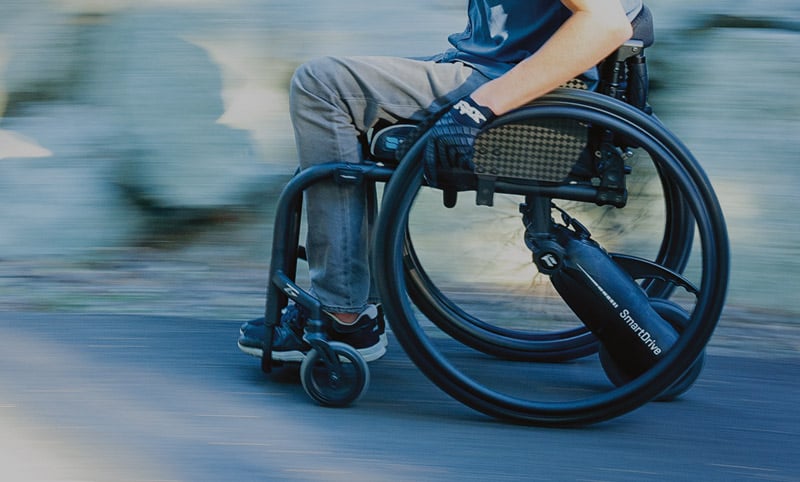Using a manual wheelchair doesn’t have to mean relying solely on your own pushing power. Power assist devices can lighten the effort, make everyday movement smoother, and open up new possibilities for independence! Whether you’re a wheelchair user exploring your options or a clinician new to the industry, understanding the different types of power assist — and how they can be controlled — helps in finding the right fit.
Quick Glance: Comparing Power Assist Types
| Assist Type | Best for | Key Perks |
|---|---|---|
| Hub-Mounted | Smooth, every-push assistance | Seamless boost, customizable settings |
| Rear-Mounted | Lightweight, flexible control | Easy removal, versatile control options |
| Rear-Mounted + SwitchControl | Custom control and sleek design | Programmable, tactile, wearable compatible |
| Front-Mounted | Rugged outdoor use and obstacle navigation | Easy attach, terrain handling, enhanced autonomy |
Drive wheel configuration can influence stability, maneuverability, and how the chair responds to the drive inputs you give. All of these are important to consider with any drive control, but when using an alternative drive control, there are some additional things to think about as well.
Hub-Mounted Power Assist

What it is: Motors and batteries are built directly into the wheels. The system kicks in when you apply force to the pushrims, activating sensors.
Why it's great:
- Every push is enhanced—no extra effort needed.
- Fully customizable with settings for speed, boost, and slope handling.
- Exceptional for rolling across varied surfaces effortlessly.
Things to know:
- Adds weight—up to 22 lbs per wheel.
- May require wheel removal for transport.
- Additional frame modifications and care in tight spaces may be needed.
Front-Mounted Power Assist: Growing in Popularity

What it is: A powered unit that attaches to the front of your wheelchair, lifting the casters and turning your chair into a “trike-style” setup.
Why it’s great:
- Handles rough terrain, grass, and curbs with ease.
- Quick to attach and remove.
- Reduces pushing effort outdoors.
Things to know:
- Adds length to the chair, which can make tight spaces harder to navigate.
- Slightly heavier and bulkier to transport than some rear-mounted options.
- Works best outdoors rather than in smaller indoor environments.
Rear-Mounted Power Assist
What it is: This lightweight, flexible option connects at the wheelchair axle. It gives you power on demand—then disengages to behave like a manual chair when not in use.
Why it’s great:
- Easy to remove and transport.
- No major changes to your wheelchair setup.
- Programmable for speed and performance to suit your environment.
- Minimal drag if the battery runs out or device is off.
Things to know:
- Requires learning a new control method (switch, wearable, or app).
- Works well indoors and outdoors but may need extra traction on steep or uneven terrain.
- Battery life depends on user weight, terrain, and settings
- Adds a small amount of weight to the chair, though generally lighter than hub-mounted options.
Rear Mounted Power assist (SmartDrive MX2+) with Switch Controls and Wearables

SwitchControl*
- Simple & Sleek: Lightweight, easy to position, and elegantly designed.
- Fully Programmable: Adjust speed, acceleration, and control mode.
- Tactile Feedback: Confirms your commands

SwitchControl with Mono-Jack Option*
- Expandable: Lets you plug in your own external switch—perfect if you need an alternate setup.
- All Benefits of SwitchControl: Plus extra flexibility.

SwitchControl with Mono Jack Option and Buddy Button*
- Friendly Design: Large, easy-to-find surface.
- Highly Accessible: Ideal if you prefer a bigger touchpoint to activate your drive.
*One option provided for free with every SmartDrive MX2+ unit purchase

Wearable App Control
- Go Hands-Free: SmartDrive works with both Apple Watch and Samsung Galaxy Watch.
- Quick & Intuitive: Tap your wrist to get rolling.
Which Option Fits You Best?
| Scenario | Best Option |
|---|---|
| Want push-assist with minimal effort | Hub-Mounted |
| Need flexibility and lightweight design | SmartDrive MX2+ Rear-Mounted |
| Value sleek design and customization | SwitchControl |
| Need alternate switch placement | SwitchControl with Mono-Jack |
| Prefer a larger activation surface | Buddy Button Option |
| Love modern, hands-free tech | Apple/Samsung Watch Control |
Clinical Tip
If you’re a clinician advising someone new to power assist, here are some things to consider:
- Start with needs, not features: Does your client need easy transportability, intuitive controls, or discreet design?
- Highlight flexibility: Review how each Power Assist device could offer or not offer a solution that adapts with the user's evolving needs
- Emphasize training: Programming and teaching users how to leverage these options means better adoption and more independence.
Final Thoughts
Power assist isn’t one-size-fits-all—and that’s the real advantage. Today’s devices offer a variety of control options that can adapt to different abilities, preferences, and lifestyles. Whether someone prefers a simple switch, a wearable tap, or a sleek, customizable interface, there’s a solution to help make mobility easier and more empowering.
We’d love to hear from you—drop in the comments below which control option you use and why it works for you!

Commercial Product Manager - Permobil Americas
Nicole B. LaBerge, PT, ATP is a Physical Therapist with 18 years of experience in a variety of clinical settings. She currently works for Permobil as a Commercial Product Manager for Manual Wheelchairs & Power Assist Devices. Her past clinical practice has included seating and mobility for adult and pediatric populations, with a focus in neurological rehabilitation, power standing and wound care. Nicole has presented at the State and International Levels, has multiple publications in peer reviewed journals and enjoys sharing her passion for patient advocacy, efficiency, and clinical outcomes. She served as an Executive Board Member for the Clinician Task Force for 3 years and is currently an active member in the CTF.


